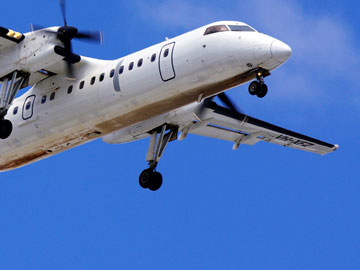
The risks associated with the handling of an approach to land have been highlighted by the ATSB after a Dash 8’s approach set off its warning system.
The incident occurred on 17 May 2012, when the flight crew of the Dash 8 was conducting a circling approach to Laverton Aerodrome in Western Australia. It departed from Perth as a passenger charter flight, with a flight crew composed of a captain and a first officer. As the crew commenced descent into Laverton, they observed that the weather in the area was mostly clear but there were bands of fog and low stratus cloud in the general vicinity of the aerodrome.
Because of the low cloud, the crew positioned the aircraft to maintain their visual reference with the runway threshold and conducted a circling approach. The resulting final approach, however, required such a high rate of descent that it triggered the aircraft’s Enhanced Ground Proximity Warning System (EGPWS). The crew heard some alerts from the EGPWS and knew they had a high rate of descent, but they did not identify an unstable approach.
...the flight crew did not have an adequate understanding of the aircraft’s EGPWS or the operator’s standard operating procedures in regard to mandatory go-arounds.
The stability of an aircraft’s final approach is an extremely important safety element. As they draw nearer to the runway, pilots need to ensure that their approach fulfils various requirements to achieve a stabilised approach. That includes being on the correct flight path to the runway touchdown point at the correct speed and with the aircraft in the landing configuration. The power setting needs to be appropriate for the aircraft configuration and the rate of descent less than 1,000 ft/min.
“If any of these requirements are not met,” says Dr Stuart Godley, head of the ATSB’s research section, “it constitutes an ‘unstable approach.’ Pilots in that situation should undertake a go-around, and try the approach again. The consequences of not doing so can be severe.” The Flight Safety Foundation cites a lack of go-arounds from unstable approaches as the number one risk factor in approach and landing accidents and the primary cause of runway excursions.
Despite the activation of the EGPWS, the flight crew of the Dash 8 continued their approach and landed safely.
The ATSB investigation found that at the time of the occurrence, the flight crew did not have an adequate understanding of the aircraft’s EGPWS or the operator’s standard operating procedures in regard to mandatory go-arounds.
In response to this occurrence, the operator refined their stabilised approach criteria and formulated a method of incorporating realistic EGPWS warning events in the Dash 8 simulator training program. This incident highlights the importance of crews adhering to standard operating procedures and correctly responding to cockpit warnings.
The issue of handling approaches to land is one of the ATSB’s safety priorities, and it forms part of the SafetyWatch web initiative.
Read the report: Unstable approach involving de Havilland Canada Dash 8, VH-XFZ, Laverton Aerodrome, Western Australia, on 17 May 2012


